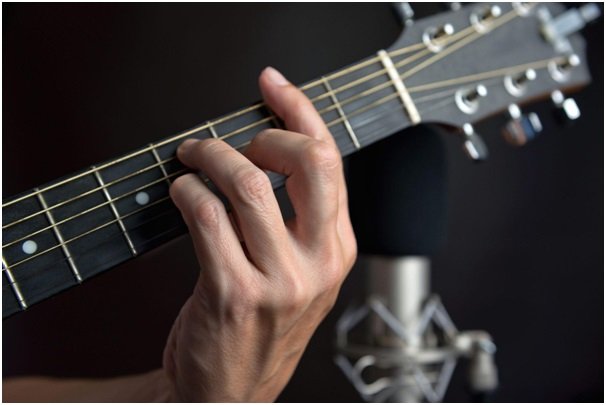Learning to play the guitar is an exciting journey, especially when you start experimenting with various chord shapes and techniques. One essential skill that every aspiring guitarist should master is playing barre chords. While they might seem challenging at first, barre chords open up a world of possibilities and significantly expand your playing capabilities. In this article, we will explore what barre chords are, their benefits, how to play them, and tips to improve your technique.
Unleash your musical potential and master this essential skill that will elevate your playing to new heights. Click here to begin your journey: Barre Chords For Beginners
What are Barre Chords?
Barre chords are a type of chord where you use one finger to press down multiple strings across the guitar’s fretboard. The finger acts as a “bar” pressing down the strings, allowing you to play different chords based on the chosen fret. Barre chords are versatile and moveable, meaning you can play various chords with the same shape by sliding them up and down the neck.
Benefits of Learning Barre Chords
Learning barre chords comes with several advantages. Firstly, they enable you to play chords in any key, providing you with greater flexibility when playing songs. Additionally, mastering barre chords enhances your finger strength and dexterity, making other guitar techniques easier to learn. They are also a fundamental component of playing more complex and melodious guitar parts, enabling you to play a wider range of musical styles.
Getting Started with Barre Chords
Understanding Finger Placement
To play barre chords successfully, proper finger placement is crucial. Choose a comfortable guitar neck position and use your index finger to press down on all the strings at a specific fret. It may feel uncomfortable at first, but with practice, your finger will develop the strength needed to hold down the strings firmly.
Common Barre Chord Shapes
There are several common barre chord shapes, each corresponding to a different chord type (e.g., major, minor, dominant seventh). Some popular shapes include the F major and B minor barre chords. Take time to learn these shapes, as they form the basis of many songs.
Practice Tips for Beginners
When starting with barre chords, patience and consistent practice are essential. Begin by practicing the basic shapes and focus on getting a clean sound from each string. Don’t get discouraged by initial difficulties; remember that practice makes perfect, and with time, you’ll improve your barre chord playing.
Overcoming Common Barre Chord Challenges
Dealing with Finger Pain
It’s not uncommon for beginners to experience finger pain when first learning barre chords. To alleviate discomfort, take short breaks during practice sessions, and stretch your fingers regularly. Over time, your fingertips will develop calluses, reducing pain and making playing more comfortable.
Achieving Clean and Clear Sound
One common challenge with barre chords is achieving a clean sound without any buzzing or muted strings. To overcome this, focus on applying even pressure with your barring finger and ensure that your other fingers are positioned correctly on the fretboard.
Building Finger Strength
Building finger strength is crucial for playing barre chords effectively. Include finger exercises in your daily practice routine, such as finger presses and finger stretches, to enhance your finger muscles.
Popular Songs Using Barre Chords
One of the best ways to practice barre chords is by learning popular songs that incorporate them. Some classic examples include “Wonderwall” by Oasis (using the F major barre chord shape) and “Brown Eyed Girl” by Van Morrison (using the G major barre chord shape).
How to Incorporate Barre Chords into Your Playing
As you become more comfortable with barre chords, you can start integrating them into your playing style. Experiment with different progressions and strumming patterns to create unique sounds and add depth to your music.
Alternatives to Barre Chords
While barre chords are incredibly useful, some alternative chord shapes may be easier for beginners. Power chords, for instance, are simple and require fewer fingers to play, making them a great starting point for beginners.
Tips for Improving Barre Chord Technique
Improving your barre chord technique takes time and dedication. Here are some additional tips to help you progress:
- Slow down and focus on accuracy before speed.
- Practice with a metronome to develop your sense of timing.
- Use visual aids, such as chord charts, to familiarize yourself with chord shapes.
Frequently Asked Questions
Are Barre Chords Necessary for Every Guitarist?
Barre chords are not mandatory, but they significantly expand your playing capabilities and versatility. Learning barre chords is highly beneficial for every guitarist.
How Long Does It Take to Master Barre Chords?
The time required to master barre chords varies for each individual. With regular practice, most guitarists become proficient in a few weeks to a few months.
Can Electric Guitarists Benefit from Barre Chords?
Absolutely! Barre chords are applicable to both acoustic and electric guitar playing, enhancing your skills across the board.
What If I Have Small Hands?
Having small hands can make barre chords more challenging, but with proper technique and practice, it is still possible to play them effectively.
Should I Use a Capo with Barre Chords?
Using a capo with barre chords can produce interesting and unique sounds. Experiment with different capo positions to find what works best for your playing style.
Conclusion
Learning barre chords may seem daunting at first, but it is a skill worth mastering for any guitarist. The ability to play chords in any key and explore new musical avenues makes barre chords indispensable. With consistent practice, patience, and a positive attitude, you’ll soon find yourself playing complex chord progressions and songs with ease.
